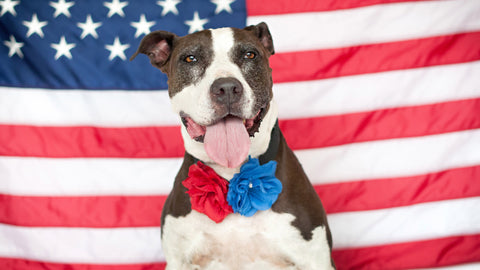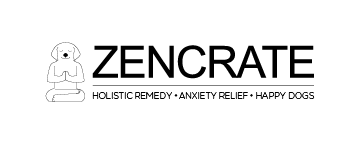The 4th of July is Stressful for Dogs and Dog Owners Alike, But it Shouldn’t Be!

The 4th of July might be fun for humans, but our four-legged friends frequently experience anxiety when the fireworks soar. Dogs react strongly to loud, abrupt noises, and frequent exposure can induce prolonged uneasiness and anxiety.
As you get ready for this Fourth of July, you should have the necessary knowledge to adequately prepare for your dog’s needs on this day. While your dog may experience anxiety for different reasons, you can soothe your canine through comforting methods that may help your furry friend get through the night. The goal is to ultimately reduce the stress-factor, and ease your animal into the holiday festivities.
Fireworks Noise and Anxiety
Before you help your companion, however, you should understand the depth of firework-induced anxiety in dogs. While not specific to the Fourth of July, firework sounds are frequently heard during the holiday. Across the nation, many reports depict anxious pups digging out of yards, running away, and even jumping through windows in response to abrupt firework sounds. Typically, a dog’s anxiety can be depicted by:
- Nervous pacing
- Hiding
- Persistent barking
- Lack of appetite
- Abrupt running
Unfortunately, many dog owners fail to understand the depth of their companion’s stress. In most cases, it’s far safer to keep pets inside during Fourth of July celebrations, rather than escorting them through outdoor activities.
Reducing Anxiety from the Get-Go
Before moving into anxiety relief methods, try to reduce your dog’s overall stress level. Prior to the firework extravaganzas, give them a good run to release any pent up energy. You’d be surprised how much a good exercise session can reduce stress.

Additionally, block outside sounds and sights by lowering the blinds, turning on the television, or playing calming music. While indoor noise might add to overall sound, your dog is likely accustomed to them and will feel more relaxed in a known environment. A lot of anxiety experienced from firework explosions comes from unpredictability. By creating a neutral, expectant audio atmosphere, you can ease your dog’s reaction to sounds and reduce their overall anxiety.
A Safe Room Creates a Safe Response
You should similarly make sure your animal is in a familiar, comforting area. Does your dog have a “favorite location in the home?” If so, direct them to it before the festivities begin. Many dogs, when stressed, retreat to similar rooms or spaces.
Strike Out the Unfamiliar Products
If your dog still experiences anxiety, or if they’re incredibly prone to anxiety from fireworks in general, you should create stable conditions in other ways. Firstly, you should avoid feeding your dog human food. While it might be tempting, sudden dietary changes can enhance your pet’s anxiety. Human food may similarly upset your animal’s stomach—further increasing stress.
Additionally, avoid spraying your dog with unfamiliar products such as insect repellant. Many human products are dangerous to canines and the Fourth of July is definitely packed with human-specific sprays, washes, drinks, and fun products, which can further induce stress due to unfamiliarity. Keep your furry friend away from the following products, particularly on the Fourth of July:
- Lighter fluid
- Matches
- Cigarette and cigar smoke
Stopping Fear in its Tracks with the ZenCrate
Today, between 20 million and 32 million dogs suffer from some sort of anxiety in the U.S. This anxiety is induced by fireworks, thunderstorms, and separation. The creators of the ZenCrate have crafted a technologically advanced solution to ease stress in dogs and dog owners alike.
The ZenCrate is intelligent, utilizing motion activated sensors to maximize care without owner presence. Controlled via Wi-Fi camera, the ZenCrate monitors and helps your furry friend so you don’t have to. Vibration-dampening feet and orthopedic memory foam make the ZenCrate a relaxing experience, greatly reducing incoming firework vibrations that cause them distress.
Every inch of the ZenCrate is protected, balanced, and enhanced by reactive adjustments. Powered by proximity sensors, the ZenCrate offers an immediate and unbeatable response. A hi-tech camera and fan, directly powered by the ZenCrate’s real-time monitoring system, comfort your animal the second they enter the crate. Motion-activated music promotes a safe space for your pet, so you needn’t cause a ruckus in managing the home’s audio. Take a load off, and give man’s best friend the immediate response they deserve.
Today’s animal shelters, veterinarians, and dog lovers are already using and loving the ZenCrate. Positive results needn’t be powered by constant human attention on the Fourth of July. Modern technology is here—powered by leading professionals.
For more information, please visit http://zendogcrate.com
Did you like this article? Show us some love, share it




